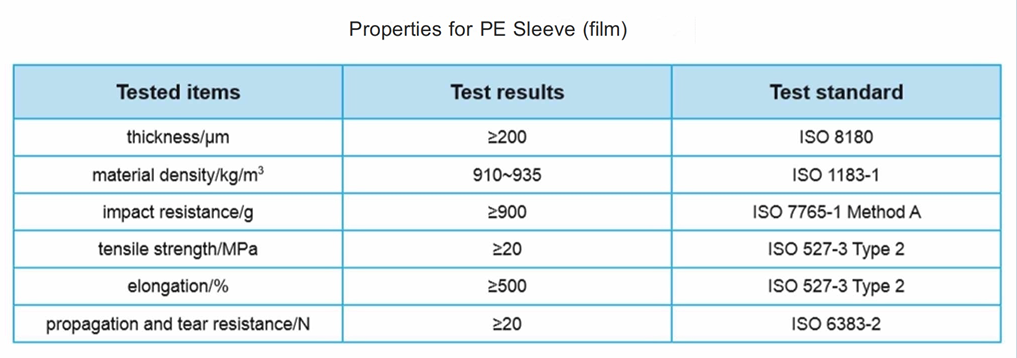We have standardization and professional service system
Ensure you enjoy the high quality and efficiency service.Product Description
Polyethylene sleeving is the Polyethylene or a mixture of polyethylene and/or ethylene and olefin copolymers sleeve (film) with a thickness of 0.2mm that is wrapped on the external walls of the pipe on the construction site. It can prevent direct contact between cast iron pipes and the soil. Meanwhile, it also prevents underground moisture from corroding the pipelines. It is used to supplement the basic pipe coating (metallic Znic + HCPE finishing layer) in certain cases of highly corrosive soils or in the presence of stray currents.
The anti-corrosion mechanisms for PE sleeve (film) wrapped outside zinc coating are as follows: First of all, PE sleeve can separate the pipelines from corrosive soil and inhibit the generation of electrochemical cells. At the same time, it can also isolate stray currents. The PE sleeve is a kind of anti-corrosion method whose performance is achieved through the changing of a corrosive environment: it can change the corrosive environment from non-homogeneous soil with strong aggressivity into one that is homogeneous with weak aggressivity.

Anti-distortion
Anti-Static Electricity corrosion
It is Cheaper than Polyurethane coating
It is suggested to adopt this kind of protective layer for corrosive soil, for example: Soil with low resistivity (with indicator of high aggressivity); Regions with stray current; Regions with high chlorine or sulphur content or active bacteria indicated by the analysis.
Polyethylene sleeving and Polyurethane coating have similar characters and property, both used in corrosive soils to protect the ductile iron pipe, but the Polyurethane coating is much more expensive than Polyethylene sleeving, so normally speaking, outside protection, Polyethylene sleeving is the best choose.
Product Features
Using polyethylene sleeving for ductile iron pipes is a common practice in the pipeline industry to provide corrosion protection to the pipes. Ductile iron pipes, while more corrosion-resistant than traditional cast iron pipes, can still be susceptible to corrosion over time, especially in certain soil conditions. Polyethylene sleeving acts as a protective barrier between the pipe and the surrounding soil, water, and other corrosive elements, thereby extending the lifespan of the pipeline.
Preparation: Before installing the ductile iron pipes, the trench or area where the pipeline will be laid is prepared. This involves excavation, ensuring proper bedding, and preparing the pipeline route.
Pipe Installation: The ductile iron pipes are laid in the prepared trench according to the project specifications and design. The pipes are typically joined using appropriate methods, such as flanged joints, mechanical joints, or restrained joints.
Polyethylene Sleeving Installation:
Once the ductile iron pipes are in place and connected, the polyethylene sleeving is applied.
The sleeving is usually provided in the form of rolls or sheets.
The sleeving is wrapped around the exterior of the ductile iron pipe, creating a protective layer that isolates the pipe from the surrounding soil.
Securing the Sleeving:
The polyethylene sleeving is secured in place using appropriate methods, such as tape, adhesive, or mechanical fasteners.
The seams and edges of the sleeving are properly sealed to ensure complete coverage and protection.
Quality Control:
Proper installation techniques are essential to ensure uniform coverage and effective protection.
Quality control measures are implemented to check for any defects or gaps in the film coverage.
Backfilling and Compaction:
Once the sleeving is in place, the trench is backfilled with suitable materials, such as gravel or sand, around the sleeved pipe.
Proper compaction is essential to provide stable support and reduce the potential for voids around the pipeline.
Final Steps:
Depending on the project requirements, additional layers of protection, such as geotextile fabric, may be added before final backfilling.
The pipeline trench is fully backfilled, compacted, and the site is restored to its original condition.
The use of polyethylene sleeving for ductile iron pipes helps prevent direct contact of the pipe with corrosive elements present in the soil, water, or other environmental factors. It can significantly extend the service life of the pipeline and reduce maintenance and repair costs over time. Proper installation techniques, including seam sealing and adequate backfilling, are crucial to ensuring the effectiveness of the sleeving in preventing corrosion and maintaining the integrity of the pipeline.
Copyright © Beijing Solaire International Corporation All Rights Reserved | Sitemap |